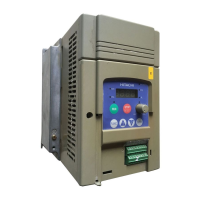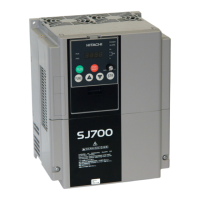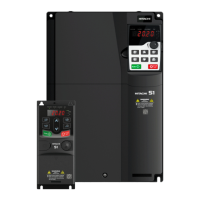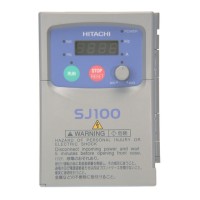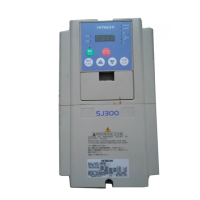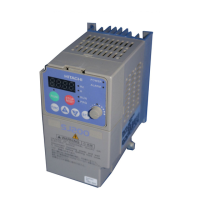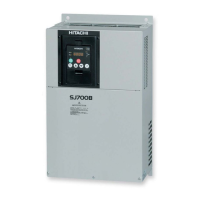Otherwise, you run the risk of electric
Be sure to ground the inverter.
Entrust wiring work to a qualified electrician.
Before wiring, be sure to turn off the power
supply and wait for 10 minutes or more.
(Confirm that the Charge lamp on the inverter is
off and the DC voltage between
Otherwise, the inverter may fail.
Do not pull the wire after wiring.
Otherwise, you run the risk of injury or
Do not connect AC power supply to
output terminals (U, V, and W).
Make sure that the voltage and frequency of AC
power supply match the rated voltage (AC input
voltage) and frequency of your inverter.
Otherwise, you run the risk of electric
Before operating the slide switch SW in the
inverter, be sure to turn off the power supply.
Since the inverter supports two modes of
fan operation, the inverter power is not
always off, even when the cooling fan is
to turn off the power supply and wait for 10
minutes or more. (Confirm that the Charge
lamp on the inverter is off and the DC voltage
between terminals P and N is 45 V or less.)
Prevent the distribution cable from being
compressed or getting caught to avoid damage
Otherwise, you run the risk of electric
Be sure to ground the inverter.
Entrust wiring work to a qualified electrician.
Before wiring, be sure to turn off the power
supply and wait for 10 minutes or more.
(Confirm that the Charge lamp on the inverter is
off and the DC voltage between
Otherwise, the inverter may fail.
Do not pull the wire after wiring.
Otherwise, you run the risk of injury or
Do not connect AC power supply to
output terminals (U, V, and W).
Make sure that the voltage and frequency of AC
power supply match the rated voltage (AC input
voltage) and frequency of your inverter.
Otherwise, you run the risk of electric
Before operating the slide switch SW in the
inverter, be sure to turn off the power supply.
Since the inverter supports two modes of
fan operation, the inverter power is not
always off, even when the cooling fan is
operating the switch, be sure
to turn off the power supply and wait for 10
minutes or more. (Confirm that the Charge
lamp on the inverter is off and the DC voltage
between terminals P and N is 45 V or less.)
Prevent the distribution cable from being
compressed or getting caught to avoid damage
Otherwise, you run the risk of electric
Be sure to ground the inverter.
Entrust wiring work to a qualified electrician.
Before wiring, be sure to turn off the power
supply and wait for 10 minutes or more.
(Confirm that the Charge lamp on the inverter is
off and the DC voltage between
Otherwise, the inverter may fail.
Do not pull the wire after wiring.
Otherwise, you run the risk of injury or
Do not connect AC power supply to
output terminals (U, V, and W).
Make sure that the voltage and frequency of AC
power supply match the rated voltage (AC input
voltage) and frequency of your inverter.
Otherwise, you run the risk of electric
Before operating the slide switch SW in the
inverter, be sure to turn off the power supply.
Since the inverter supports two modes of
fan operation, the inverter power is not
always off, even when the cooling fan is
operating the switch, be sure
to turn off the power supply and wait for 10
minutes or more. (Confirm that the Charge
lamp on the inverter is off and the DC voltage
between terminals P and N is 45 V or less.)
Prevent the distribution cable from being
compressed or getting caught to avoid damage
Otherwise, you run the risk of electric
Entrust wiring work to a qualified electrician.
Before wiring, be sure to turn off the power
(Confirm that the Charge lamp on the inverter is
Otherwise, you run the risk of injury or
Make sure that the voltage and frequency of AC
power supply match the rated voltage (AC input
Otherwise, you run the risk of electric
Before operating the slide switch SW in the
inverter, be sure to turn off the power supply.
Since the inverter supports two modes of
fan operation, the inverter power is not
always off, even when the cooling fan is
operating the switch, be sure
to turn off the power supply and wait for 10
minutes or more. (Confirm that the Charge
lamp on the inverter is off and the DC voltage
between terminals P and N is 45 V or less.)
compressed or getting caught to avoid damage
Otherwise, you run the risk of electric
Otherwise, you run the risk of short circuit
Do not remove rubber bushings from the wiring
section. Otherwise, the edges of the wiring
cover may damage the wire.
Do not connect a resistor directly to any of the
DC terminals (PD, P, and N).
Do not use the magnetic contactor installed on
the primary and secondary sides of the inverter
Tighten each screw and bolt to the specified
No screws and bolts must be left loose.
Use only the power cables, earth
breaker, and magnetic contactors that have the
specified capacity (ratings).
Otherwise, you run the risk of damage to
the inverter and motor burnout.
Do not operate the inverter when an output
phase is lost (output phase loss).
Safety Instructions/Risks
Otherwise, you run the risk of electric
wiring only after installing the inverter.
Otherwise, you run the risk of short circuit
Do not remove rubber bushings from the wiring
section. Otherwise, the edges of the wiring
cover may damage the wire.
Otherwise, you run the risk of fire.
Do not connect a resistor directly to any of the
DC terminals (PD, P, and N).
Do not use the magnetic contactor installed on
the primary and secondary sides of the inverter
Tighten each screw and bolt to the specified
No screws and bolts must be left loose.
Use only the power cables, earth
breaker, and magnetic contactors that have the
specified capacity (ratings).
Otherwise, you run the risk of damage to
the inverter and motor burnout.
Do not operate the inverter when an output
phase is lost (output phase loss).
Safety Instructions/Risks
Otherwise, you run the risk of electric
wiring only after installing the inverter.
Otherwise, you run the risk of short circuit
Do not remove rubber bushings from the wiring
section. Otherwise, the edges of the wiring
cover may damage the wire.
Otherwise, you run the risk of fire.
Do not connect a resistor directly to any of the
DC terminals (PD, P, and N).
Do not use the magnetic contactor installed on
the primary and secondary sides of the inverter
Tighten each screw and bolt to the specified
No screws and bolts must be left loose.
Use only the power cables, earth
breaker, and magnetic contactors that have the
specified capacity (ratings).
Otherwise, you run the risk of damage to
the inverter and motor burnout.
Do not operate the inverter when an output
phase is lost (output phase loss).
Safety Instructions/Risks
Otherwise, you run the risk of electric
wiring only after installing the inverter.
Otherwise, you run the risk of short circuit
Do not remove rubber bushings from the wiring
section. Otherwise, the edges of the wiring
Otherwise, you run the risk of fire.
Do not connect a resistor directly to any of the
Do not use the magnetic contactor installed on
the primary and secondary sides of the inverter
Tighten each screw and bolt to the specified
No screws and bolts must be left loose.
Use only the power cables, earth
breaker, and magnetic contactors that have the
Otherwise, you run the risk of damage to
the inverter and motor burnout.
Do not operate the inverter when an output
phase is lost (output phase loss).
Safety Instructions/Risks
wiring only after installing the inverter.
Otherwise, you run the risk of short circuit
Do not remove rubber bushings from the wiring
Do not connect a resistor directly to any of the
Do not use the magnetic contactor installed on
the primary and secondary sides of the inverter
breaker, and magnetic contactors that have the
Otherwise, you run the risk of damage to
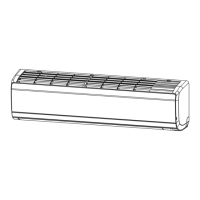
